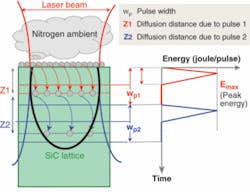LASER MATERIALS PROCESSING: SiC white LEDs fabricated by laser doping
Researchers at The Center for Research and Education in Optics and Lasers (CREOL) at the University of Central Florida (Orlando, FL) and at AppliCote Associates (Sanford, FL) have used a laser-doping process to fabricate white-light-emitting diodes (LEDs) in a silicon carbide (SiC) substrate.1
Unlike growth-based fabrication techniques for LEDs—such as conventional liquid-phase epitaxy, vapor-phase epitaxy, metalorganic epitaxial chemical vapor deposition, and molecular-beam epitaxy—the direct-write laser-doping technique enables the use of unconventional dopants to customize emission wavelengths, allows for selective-area doping, and reduces the number of fabrication steps. And, unlike ion-implantation techniques specific to SiC device fabrication, laser doping reduces defect centers and surface damage and provides dopant activation in a single step.
A process called laser-induced solid-phase doping (LISPD) is used, in which the substrate or wafer is not melted as in other laser-based doping techniques such as laser thermal processing and gas-immersion laser doping. Instead, LISPD relies on solid-state diffusion for dopant incorporation through the dopant gas method, in which the wafer is placed in a dopant-containing gaseous environment of organometallic compounds and the wafer irradiated by a laser beam (see figure). The substrate is maintained at room temperature during the entire process. The gas decomposes at the laser-heated spot and the dopant atoms diffuse into the wafer. Laser-doped tracks are formed on the sample surface by moving the chamber on a stepper-motor-controlled stage. By injecting different n- and p-based dopants within the chamber, p-n junctions can be generated on the substrate—the basis for optoelectronic components such as p-i-n photodiodes and LEDs.
To fabricate the LEDs in the SiC substrate (6H-SiC and 4H-SiC; polytypes of SiC), the researchers used a 1064 nm Nd:YAG laser as the source. The emission of different colors to ultimately generate white light in SiC is tailored on the basis of the donor-acceptor-pair (DAP) recombination mechanism for luminescence. Chromium (Cr), which is an unconventional dopant that produces multiple acceptor sites per atom, was incorporated into SiC; conventional dopants such as aluminum (Al) and nitrogen (N) were also laser-doped to produce acceptor and donor states, respectively. A p-n junction was fabricated with these dopants and an electroluminescent broad spectrum (400-850 nm) corresponding to white light was observed. This white light is a result of the combination of red, green, and blue lights formed due to DAP recombination between Al-N (blue; 460-498 nm), Cr-N (green; 521-575 nm), and an additional transition between the nitrogen and defect states (red; 698-738 nm).2
“Unlike ion implantation, laser doping does not damage compound semiconductor structures and dopes deeper and faster, particularly in the case of p-type dopants in these materials,” says researcher Aravinda Kar. “The process is suitable for doping semiconductor materials with multiple as well as multidonor and multiacceptor dopants for fabricating devices with innovative designs. This technology has the potential to reduce processing steps and is an enabling technology for rapid prototyping—significantly shortening the time to convert a design into manufactured products.”
REFERENCES
1. S. Bet et al., ICALEO 2006, paper M606, Scottsdale, AZ (October 2006).
2. S. Bet et al., submitted to J. Laser Applications (November 2006).
About the Author

Gail Overton
Senior Editor (2004-2020)
Gail has more than 30 years of engineering, marketing, product management, and editorial experience in the photonics and optical communications industry. Before joining the staff at Laser Focus World in 2004, she held many product management and product marketing roles in the fiber-optics industry, most notably at Hughes (El Segundo, CA), GTE Labs (Waltham, MA), Corning (Corning, NY), Photon Kinetics (Beaverton, OR), and Newport Corporation (Irvine, CA). During her marketing career, Gail published articles in WDM Solutions and Sensors magazine and traveled internationally to conduct product and sales training. Gail received her BS degree in physics, with an emphasis in optics, from San Diego State University in San Diego, CA in May 1986.
